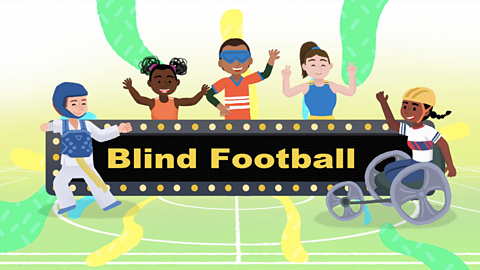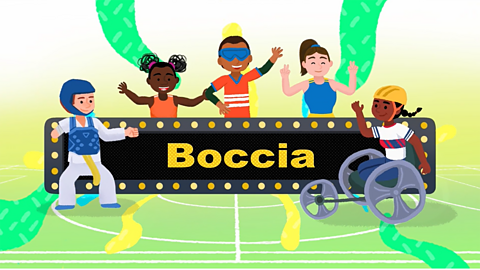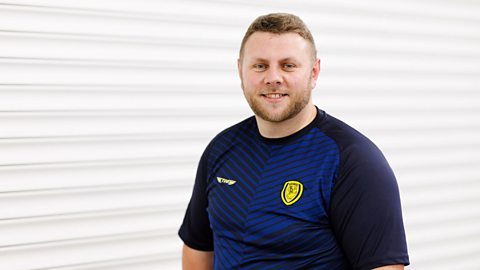PATTERING FEET, CHILDREN'S VOICES
UPLIFTING MUSIC
MARTIN DOUGAN: Welcome to the Super Movers for Every Body guide to some of the athletic events youãll see ParalympicsGB athletes competing in.
One thing is for sure, weãve got some big names for you to meet.
Check it out!
HOLLIE: Hi, Iãm Hollie Arnold and when I was fourteen, I went to my first Paralympic Games in Beijing 2008.
THOMAS: Iãm Thomas Young, I am a gold medal-winning Paralympian and I compete in the 100 metre sprint.
FUNMI: And I am Funmi Oduwaiye. Iãm hoping to follow in Thomas and Hollieãs footsteps in representing ParalympicsGB in shot put.
These sports are just a few of the track and field events, Para athletes from all over the world compete in for medals at the Paralympic Games, which takes place every four years.
CLAPPING
HOLLIE: I was born without my right forearm but that never stopped me loving sport.
When I was eleven, me and my brother went to a sporting event.
He picked up the javelin first; I wanted to beat him.
And thatãs when I realised I love the javelin.
When I went to my first Paralympic Games, I was the youngest ever athlete to compete.
I was so proud and excited to represent ParalympicsGB.
Since then, Iãve been to every games, winning my gold medal at Rio 2016 and a bronze at Tokyo 2020.
But my world record throw of 43.01 metres is probably one of my best sporting achievements so far.
MARTIN: Like all Paralympic athletes, Hollie competes with others who have a similar impairment to hers, to make it fair.
And the idea is to launch the javelin as far as possible.
HOLLIE: It might seem easy to throw a javelin far, but it takes skill, time and patience.
The javelin that I use weighs 600 grams and I can throw that over 40 metres.
MARTIN: Thatãs like throwing this bottle of water from hereãÎall the way over to here.
Now, thatãs impressive.
Pretty thirsty work as well.
CHEERING
MARTIN: When it comes to Para athletics on the track, there are athletes with all kinds of different impairments, who race set distances.
In wheelchair racing, the wheelchairs are specifically designed for speed.
In other races, athletes who have a limb difference wear specially made prosthetic blades to help them run as fast as possible.
And there are runners who are blind or visually impaired.
They can run with a sighted guide who helps them stay on track, and hopefully, win the race.
THOMAS: My first Paralympic Games were the Tokyo 2020 Games.
There, I won a gold medal and ran a time of 10.94 seconds in the 100 metre sprint, which was just a second slower than Usain Boltãs Olympic record.
The next day, I woke up to a message from Usain Bolt, saying,
ãAnything is possible. Donãt think limit.ã
How cool is that?
MARTIN: To be this fast, Thomas has to be very dedicated. He trains five days a week and competes at events all around the world.
And heãs always been determined to be the best.
THOMAS: Iãve got NF1 which affects the nerves in my body, which means I find balance and coordination more difficult.
I started running in primary school and enjoyed it so much.
When I was twelve years old, I was diagnosed and that gave me lots of answers to why I struggled with my handwriting and couldnãt ride a bike,
but that didnãt make me want to stop becoming successful in my sport.
There is something just so great about running quickly, especially when youãre out in front and you can hear the crowd cheering you on.
COMMENTATOR: ãÎThomas Young to take Paralympic Gold for Great Britain!
MARTIN: In order for British athletes to keep winning medals, itãs important to find the next generation of sporting talent.
Thatãs where 21-year-old, Funmi Oduwaiye, from Cardiff, comes in.
FUNMI: Iãve always been into sport.
My mum put me in swimming, tennis, figure skating, rugby, you name it.
MARTIN: When Funmi turned sixteen, she had an operation on her right knee.
The surgery didnãt work and Funmiãs leg couldnãt be fixed, so sheãs now affected from the knee down.
FUNMI: After my operation, I was referred to see Disability Sport Wales.
Shot put seemed to come naturally, so I started to train in that, and that was around two years ago.
MARTIN: The womenãs competition uses a ball that weighs four kilograms.
Thatãs about the same as four pineapples.
FUNMI: Most people donãt realise how technical and difficult shot put is.
The ball has to be held against your neck with one hand, before itãs pushed, not thrown, as far as possible.
Itãs a lot to get right.
MARTIN: Funmiãs personal best throw is 11.03 metres.
Thatãs like travelling from the back of a double-decker busãÎ
ãÎ all the way to the front.
The secret behind her success is preparation and technique.
FUNMI: Because of the issues with my leg, I have difficulty controlling it, so I have to put on what I call, ãMy throwing leg.ã
Itãs a hard plastic splint that helps control my foot, so I can concentrate on the throw.
Some competitors spin and some choose not to.
In some Para shot put classifications, all athletes have to throw from a seated position.
Now, thatãs hard.
MARTIN: Para athletics is now practised by thousands of athletes in more than 130 countries around the world.
And you could be next!
CAMERA CLICKS
PATTERING FEET, CHILDREN'S VOICES
Watch this film with British Sign Language
Watch this film with audio description
Watch this film with British Sign Language and audio description.
Martin Dougan introduces us to some famous Paralympians who share their experience of Paralympic sports.
The first Paralympic Games took place in Rome in 1960. Twenty three nations and 400 wheelchair athletes took part.
At the Paralympic Games in Toronto in 1976, athletes who weren't in wheelchairs were allowed to take part for the first time, so amputees and athletes with a visual impairment were able to compete.
Para athletics is now practised in more than 130 countries around the world and includes track and field events such as wheelchair racing, running, marathon, long jump, triple jump, high jump, javelin, discus, club throw and shot put.
In this film, we meet champion athletes who share their inspiring stories and passion for their sport:
- Hollie Arnold MBE, javelin world champion
- Thomas Young MBE, gold medal-winning 100m sprinter
- Funmi Oduwaiye, shotput star
They have all shown, in the words of champion sprinter Usain Bolt in his motivational message to Thomas Young:
ãAnything is possible. Donãt think limit.ã
You can watch the 2024 Paralympic Games between 28th August and 8th September on Channel 4.



